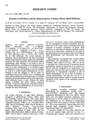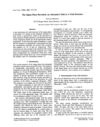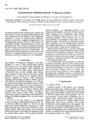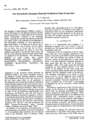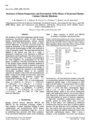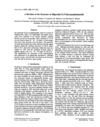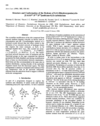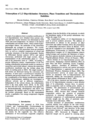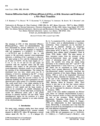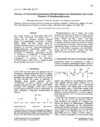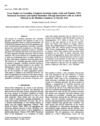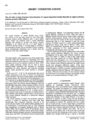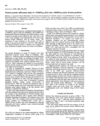issue contents
October 1996 issue

Cover illustration: Polar diagram and side views of two aza-18-crown-6 macrocyclic compounds. Courtesy of R. Kiralj, B. Kojic-Prodic, M. Zinic, S. Alihodzic and N. Trinajstic
topical reviews
Solution of crystal structures from electron-diffraction intensity data is reviewed. Important applications include small organics, lipids, linear polymers, membrane proteins and even a variety of inorganic materials.
research papers
Download citation


Download citation


All lithium-free mixed alkali disilicate glasses are hygroscopic. The crystal structure of KLiSi2O5, a sheet silicate topologically equivalent to Li2Si2O5 and Na2Si2O5, has been determined in an attempt to rationalize by classical valence arguments the role of lithium in preventing hygroscopicity.
Trial structure determination is based on the initial assumption of tetrahedral close packing with only unit-cell dimensions, metallic radii and possible space groups as the required information.
Download citation


Download citation


The tunnel structure of Ba0.85Ca2.15In6O12 has been refined using the Rietveld method. The incommensurate occupational and displacive modulation has been characterized.
Download citation


Download citation


Analysis of the 128 different structures listed under point group 4mm in the Inorganic Crystal Structure Database has resulted in the prediction of 51 ferroelectrics, of which only eight were previously known to exhibit this property.
Download citation


Download citation


Structural analysis of three recent entries in the Inorganic Crystal Structure Database under space group Pba2 predicts aminoguanidinium(2+) hexafluorozirconate to be ferroelectric, with Ba0.6K0.4BiO2.3 also ferroelectric if the three reported O-atom displacements are confirmed, and (Cl3PNPCl3)(MoOCl4) to be centrosymmetric if the Mo sites are equally occupied; otherwise, pyroelectric but not ferroelectric.
Download citation


Download citation


The distortion of the ferroelectric phase is analyzed in terms of symmetry modes and then compared with the modulations of the incommensurate and fourfold phases.
Download citation


Download citation


The apparently satisfactory structural determination previously reported is incorrect. New data show a substantially different packing interaction arising from a doubling of the original c axis. Implications of this error are discussed.
CCDC reference: 131602
Download citation


Download citation


The crystal structures of 5,6-dimethylphenanthridinium triflate and two alkali metal complexes of aza-and diaza-18-crown-6 with single- and two-armed fluoroionophores bearing phenanthridine units are presented. The evaluation of C-C and C-N bonds in phenanthridine by semi-empirical and molecular-mechanics calculations is performed and compared with the results of valence-bond and Hückel molecular-orbital calculations.
Download citation


Download citation


Crystallization of the title cage compound at high pH proceeds by way of a hydrogen-bond network around a central H2O of hydration. This locks the functional region into a specific orientation, irrespective of chirality. Rather than occupy inversion-related positions, enantiomers therefore share sites to produce disorder around the handle of the cage.
CCDC reference: 131599
Download citation


Download citation


The crystal structure of an unknown third modification of 2,2'-dipyridylamine was determined at 150 K and room temperature and the phase transitions and thermodynamic stabilities of all three forms were investigated by differential thermal analysis, powder diffraction and temperature-dependent crystallization experiments.
Download citation


Download citation


[Pt(en)2][Pt(en)2I2](ClO4)4 containing mixed-valence PtI chains has been studied for the first time by neutron diffraction. A phase transition characterized by a doubling of the c parameter has been discovered in the vicinity of 160 K and the refinement of the structure at 20 K revealed that the space group is C2/c.
CCDC reference: 131604
Download citation


Download citation


The crystal structure of (C6H11NH3+)3.Pep3−.H2O is reported and the structures of 19 other phosphoenolpyruvates are reviewed.
CCDC reference: 131603
Download citation


Download citation


Aqueous solutions of DL-histidine and glycolic acid yield crystals of L-histidine glycolate and D-histidine glycolate, in addition to those of DL-histidine glycolate; the crystal structures of DL-histidine glycolate and L-histidine glycolate provide a structural rationale for the separation of optical isomers.
Symmetry-modified Cremer-Pople principal component and cluster analyses are used to map and classify the crystallographically observed conformations of parent cyclooctanes and a variety of unsaturated and heterocyclic analogues.
short communications
Download citation


Download citation


The crystal structure of methyl fluoride (m.p. = 195 K) at 5 K has been routinely solved ab initio from high-resolution neutron powder diffraction data using a vapour deposition technique for sample preparation. The monoclinic structure may be described in terms of dipole-dipole intermolecular interactions and is distinct from the structures of the other methyl halides.
CCDC reference: 131601
Download citation


Download citation


The complete crystal structure, including H-atom positions, of α-Ti(HPO4)2.H2O (α-TiP) and α-Hf(HPO4)2.H2O (α-HfP) were determined by Rietveld refinement and Fourier synthesis, using constant-wavelength neutron diffraction data.


 journal menu
journal menu












